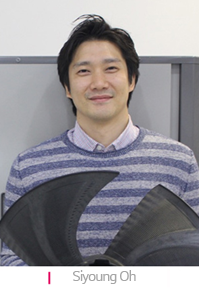LG Electronics and Seoul National University disclosed that they had discovered a solution for reducing noise and improving energy efficiency from marine life and implemented this solution in system air conditioning products through a joint research collaboration. The collaborative research effort by Seoul National University and LG Electronics produced a biomimicry fan for air conditioning units that implement the shape of both the fins of humpback whales and clam shells to decrease noise emission and reduce energy consumption by 10%.
This technology received a Korean patent (patent number: 10-1483340) in January of 2015 and obtained NET certification (number: 0937. NET, or New Excellent Technology, is an innovative technology certification organization in Korea) in August of 2015. The technology was implemented in LG Electronics’ high-efficiency system air conditioner, Multi V 5, which was released in October of 2015. We had a chance to meet the members of Home Appliance & Air Solution Company Air Solution R&D Lab. involved in developing this innovative technology.
Interview with Multi V 5 Developers Yongcheol Sa, Seokho Choi and Siyoung Oh
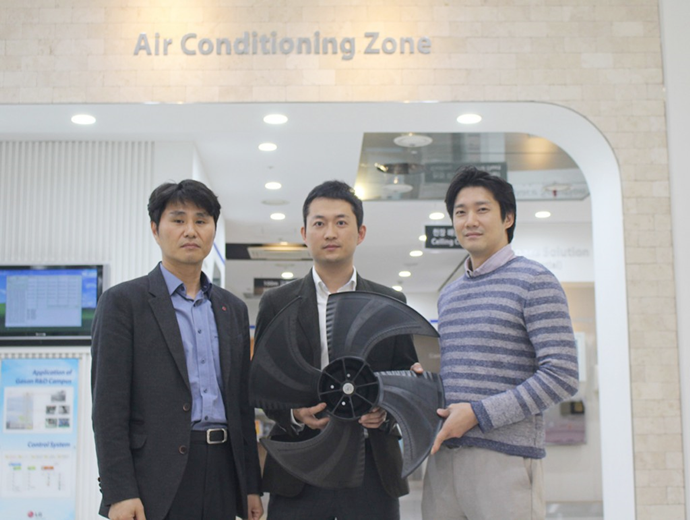
Q1. Please give us an introduction to the Air Solution R&D Lab
We conduct advanced research at the Air Solution Research Center to develop new technology and elevate our competitive edge in system air conditioning to a global level. System air conditioning is a comprehensive term that refers to a wide range of heating, cooling and ventilation systems tailored to fit a new building or renovation development by connecting outdoor and indoor HVAC units together. Rapidly growing system air conditioners are economical, efficient and reduce initial investment and operating costs by allowing system conversion from cooling to heating mode.
Q2. I heard that you are combining biomimicry technology to harness both sound emission and energy consumption. Tell us what kind of technology this entails.
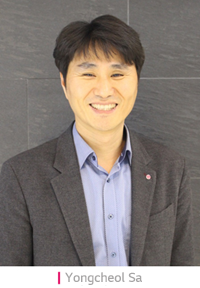
The current system air conditioning market is trending towards increasing the maximum capacity of single unit air conditioners in order to reduce initial costs and simplify the installation process. This trend makes it necessary to increase the air volume of outdoor units to improve maximize system capacity without increasing the size of the products. However, when the air volume of outdoor units increases, so does the sound emission and energy consumption of the axial-flow fan. Therefore, development of a low-noise, high-efficiency axial-flow fan was needed.
Firstly, air flow visualization methods were implemented to test the axial-flow fans, which allowed us to better understand the flow loss of the fans. LG and Seoul National University then used this information and began biomimicry technology research to resolve these issues and develop ideas from studying nature. We explored various types of biomimicry technology and ultimately used concept of humps on the fins of humpback whales and the ridges on the surface of clam shells and applied them to axial-flow fans in order to find ways that we could reduce sound emission and improve efficiency.
We found that the concept behind the way humps on humpback whale fins allows the fins to glide naturally though the water could reduce separation of suction side on an axial-flow fan. We also discovered that the shape of clam shells help keep clams from being swept up in ocean tides and waves, and this concept could be applied to the surface of axial-flow fans to reduce loss and improve performance.
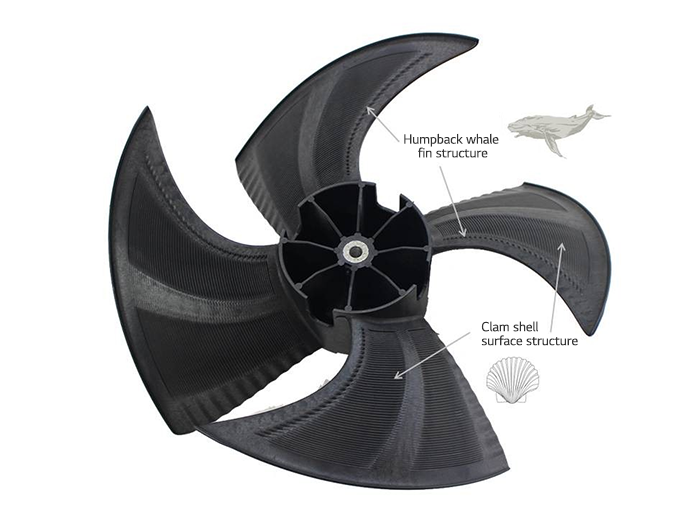
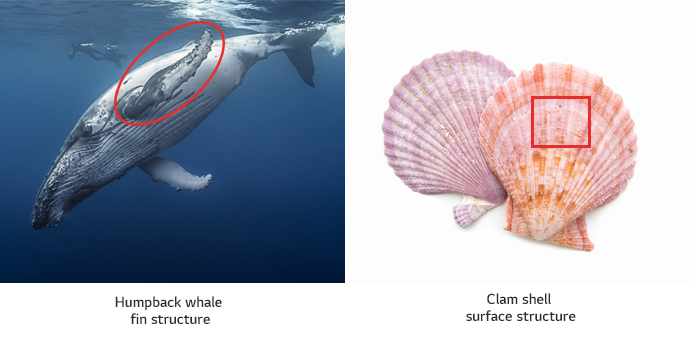
The biomimicry loss control axial-flow fan that resulted from a combination of LG Electronics’ axial-flow fan design technology and Seoul National University professor Haecheon Choi’s biomimicry technology reduced sound emission by 2dB and improved efficiency by 10%. The current biomimicry loss control axial-flow fan implemented in the top-rated efficiency Multi V 5 received NET certification and the original fan design received a patent from the Korean patent office.
Q3. A 2dB sound reduction and 10% efficiency increase is impressive. Was it difficult to develop this technology with LG Electronics and Seoul National University joint research team?
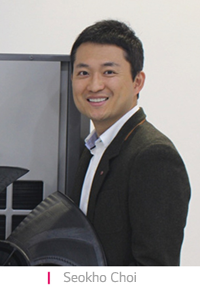 Seokho Choi The most difficult part of the project was applying the biomimicry form to the actual fan. In the initial stages of development, the team at Seoul National University attached small beads and foam to fans in order to replicate the form of humps on humpback whales fins. But the beads and foam began to fall off the fan as the fan rotated at high speeds.
Seokho Choi The most difficult part of the project was applying the biomimicry form to the actual fan. In the initial stages of development, the team at Seoul National University attached small beads and foam to fans in order to replicate the form of humps on humpback whales fins. But the beads and foam began to fall off the fan as the fan rotated at high speeds.
Eventually, LG Electronics upgraded the capabilities of its fan design program and they began to develop fans with humps on them. They used UG (3D CAD) design and integrated the hump form with the fin shape to create a fan mockup. It was also difficult to figure out exactly where the humps should be located on the fins of the fan. A lot of analysis was required to determine where the humps should be located but a 6 Sigma based test plan was utilized to optimize the testing process and find the most efficient location.
When we first applied the clam shell groove design to the fan, we used projection molding to create the grooves, but there were issues with the fan shape warping during the cooling process. We came up with many ideas to overcome these issues but in the end we found that we could reduce warping on the fan by digging the grooves into the fan.
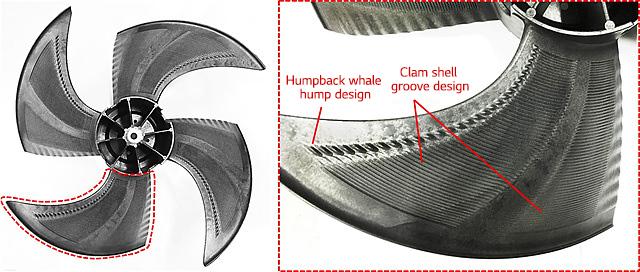
Siyoung Oh
The collaboration proved to be very effective in giving us a precise understanding from the beginning. We were able to obtain reliable results from understanding air flow loss in the first stage of development and with this foundation, we developed ideas for biomimicry technology and proceeded with meticulous attention to detail. In the process of repeatedly reviewing ideas, the researchers at Seoul National University worked enthusiastically and we conducted many experiments together to make this technology possible. This is the first time I have conducted so much research in a joint collaboration.
Q4. What sort of product is the ‘Multi V 5’ that we have been hearing so much about?
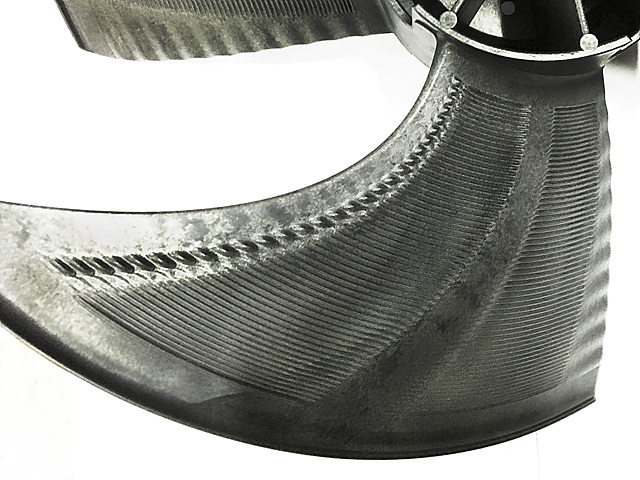
Close-up of the LG System Air Conditioner Fan Fin
Multi V 5 is our next generation air conditioner with a high-efficiency inverter compressor, a 4 surface heat exchanger that improves energy efficiency 11% over the Multi V 4 and 20-26HP capacity. Also, it is the first air conditioner system in the world to have humidity sensors in both the outdoor compressors and indoor units that detect temperature and humidity to reduce energy consumption when there are frequent changes in humidity and drastically reduce electricity fees.
Q5. What efforts are you making to gain insight for the sake of the consumer?
Fans can be installed on their own but they are usually installed in different types of products. So, we focus on products and fans that can be utilized in other fields besides air conditioning as well. For example, even smaller scale, low-noise axial-flow fans used to cool CPUs and the durable, high-pressure airplane engine fans give us insight into very specialized technology. We make lists of these technologies and categorize them so that we can refer to the lists during the design process.
Q6. What’s the most important thing you have gotten out of this development project experience?
Seokho Choi Bringing a new product from R&D to mass production is a difficult process. The most important thing in facing these difficulties and resolving these problems is a positive mind. By keeping a positive mind and maximizing the advantages of a technology or product, you can overcome obstacles and get positive results.
Siyoung Oh As a senior researcher, I have some advice to give to new researchers: ‘Don’t break your neck just trying to work hard. Finding the work you truly want to do is also important’. Of course, working hard is essential, but if you only devote yourself to what is right in front of you, it is easy to miss big opportunities. Don’t merely focus on what is in front of you, but if you find work worth doing, you will reap more benefits, find more efficient ways to accomplish things and reach your full potential.
Final thoughts…
We’ve now finished our interview with the 3 researchers responsible for the planning and development of the low-noise, high-efficiency fan. This interview really sparked my interest in biomimicry technology and I was fascinated to hear about the research and development process for this project. I hope the insight gained in this project will produce even more innovative products in the future.
Written by Seontaek kim, LG Electronics
Seontaek kim is managing product development and GCAC technical support in Home Appliance & Air Solution Company Air Solution R&D Lab.
Post Views:
12,665




 Seokho Choi The most difficult part of the project was applying the biomimicry form to the actual fan. In the initial stages of development, the team at Seoul National University attached small beads and foam to fans in order to replicate the form of humps on humpback whales fins. But the beads and foam began to fall off the fan as the fan rotated at high speeds.
Seokho Choi The most difficult part of the project was applying the biomimicry form to the actual fan. In the initial stages of development, the team at Seoul National University attached small beads and foam to fans in order to replicate the form of humps on humpback whales fins. But the beads and foam began to fall off the fan as the fan rotated at high speeds.

